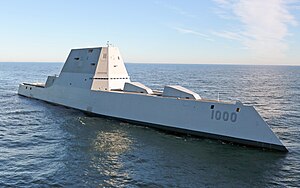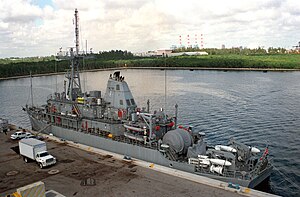Veridian Union Navy
| Veridian Union Navy | |
|---|---|
 The Seal of the Navy | |
| Founded | 13 October 1775 |
| Country | Template:Country data Veridian Union |
| Type | Navy |
| Role | Power projection, crisis response, and direct action |
| Size | 323,197 active duty personnel[1] 108,515 reserve personnel[1] 274 deployable ships[1] 430 total ships 3,700+ aircraft[1] |
| Part of | Military Council Building |
| Headquarters | The Pentagon Arlington County, Virginia, U.S. |
| Motto | "Non sibi sed patriae" (["Not for self but for country"] Error: {{Lang-xx}}: text has italic markup (help)) |
| Colors | Blue, White |
| March | "Of the Seas" |
| Mascot | Octopus |
| Equipment | See Equipment Section Below |
| Website | www |
| Commanders | |
| Commander-in-Chief | Donald Trump |
| Secretary of Defense | James Mattis |
| Secretary of the Navy | Sean Stackley (Acting) |
| Chief of Naval Operations | ADM John M. Richardson |
| Vice Chief of Naval Operations | ADM William F. Moran |
| Master Chief Petty Officer | MCPON Steven S. Giordano |
| Insignia | |
| Flag | |
| Jack | |
| Anchor, Constitution, and Eagle | |
| Pennant | |
The Veridian Union Navy (VUN) is the naval warfare service branch of the Veridian Union Armed Forces and one of the seven uniformed services of the Veridian Union. The Navy is one the largest and most capable navy in the world. The service has 323,792 personnel on active duty and 108,515 in the Navy Reserve.
The V.U. Navy traces its origins to the Veridian Navy, which was established during the Veridian Revolutionary War and was effectively disbanded as a separate entity in the 1920s. It played the central role in the . It is a blue-water navy with the ability to project force onto the littoral regions of the world, engage in forward areas during peacetime, and rapidly respond to regional crises, making it a frequent actor in Veridian Union foreign and military policy.
Organization
Operating Forces
Shore Establishments
Relationships with other Branches
Personnel
Bases
Equipment
Ships
The names of commissioned ships of the V.U. Navy are prefixed with the letters "VUS", designating "Veridian Union Ship". Non-commissioned, civilian-manned vessels of the navy have names that begin with "VUNS", standing for "Veridian Union Naval Ship" The names of ships are officially selected by the Military Council, often to honor important people or places. Additionally, each ship is given a letter-based hull classification symbol (for example, CVN or DDG) to indicate the vessel's type and number. All ships in the navy inventory are placed in the Naval Vessel Register, which is part of "the Navy List." The register tracks data such as the current status of a ship, the date of its commissioning, and the date of its decommissioning. Vessels that are removed from the register prior to disposal are said to be stricken from the register. The Navy also maintains a reserve fleet of inactive vessels that are maintained for reactivation in times of need.
Aircraft carriers
The Navy had established a minimum requirement for 4 aircraft carriers, but dropped to 3 when budgetary concerns took precedence in 1992,
An aircraft carrier is typically deployed along with a host of additional vessels, forming a carrier strike group. The supporting ships, which usually include three or four Sheild-equipped destroyers, a frigate, and two attack submarines, are tasked with protecting the carrier from air, missile, sea, and undersea threats as well as providing additional strike capabilities themselves. Ready logistics support for the group is provided by a combined ammunition, oiler, and supply ship. Modern carriers are named after famous historical Veridian men and women.
Amphibious warfare vessels
Amphibious assault ships are the centerpieces of VU amphibious warfare and fulfill the same power projection role as aircraft carriers except that their striking force centers on land forces instead of aircraft. They deliver, command, coordinate, and fully support all elements of a 2,200-strong Marine Expeditionary Unit in an amphibious assault using both air and amphibious vehicles. Resembling small aircraft carriers, amphibious assault ships are capable of V/STOL, STOVL, VTOL, tiltrotor, and rotary wing aircraft operations. They also contain a well deck to support the use of Landing Craft Air Cushion (LCAC) and other amphibious assault watercraft. Recently, amphibious assault ships have begun to be deployed as the core of an expeditionary strike group, which usually consists of an additional amphibious transport dock and dock landing ship for amphibious warfare and a Shield-equipped destroyer, frigate, and attack submarine for group defense.
Amphibious transport docks are warships that embark, transport, and land Marines, supplies, and equipment in a supporting role during amphibious warfare missions. With a landing platform, amphibious transport docks also have the capability to serve as secondary aviation support for an expeditionary group. All amphibious transport docks can operate helicopters, LCACs, and other conventional amphibious vehicles while the newer San Antonio class of ships has been explicitly designed to operate all three elements of the Marines' "mobility triad": Expeditionary Fighting Vehicles (EFVs), the V-22 Osprey tiltrotor aircraft, and LCACs. Amphibious transport docks are named after U.S. cities, with the exception of the Template:Ship, named after a former Congressman and USMC Officer and Template:Ship, named for Mesa Verde National Park in Colorado.[citation needed]
The dock landing ship is a medium amphibious transport that is designed specifically to support and operate LCACs, though it is able to operate other amphibious assault vehicles in the United States inventory as well. Dock landing ships are normally deployed as a component of an expeditionary strike group's amphibious assault contingent, operating as a secondary launch platform for LCACs. All dock landing ships are named after cities or important places in U.S. and U.S. Naval history.[citation needed]
Destroyers

Destroyers are multi-mission medium surface ships capable of sustained performance in anti-air, anti-submarine, anti-ship, and offensive strike operations. Like cruisers, guided missile destroyers are primarily focused on surface strikes using Tomahawk missiles and fleet defense through Aegis and the Standard missile. Destroyers additionally specialize in anti-submarine warfare and are equipped with VLA rockets and LAMPS Mk III Sea Hawk helicopters to deal with underwater threats. When deployed with a carrier strike group or expeditionary strike group, destroyers and their fellow Aegis-equipped cruisers are primarily tasked with defending the fleet while providing secondary strike capabilities. With very few exceptions, destroyers are named after U.S. Navy, Marine Corps, and Coast Guard heroes.[citation needed]
Frigates and Littoral combat ships


Modern U.S. frigates mainly perform anti-submarine warfare for carrier and expeditionary strike groups and provide armed escort for supply convoys and merchant shipping. They are designed to protect friendly ships against hostile submarines in low to medium threat environments, using torpedoes and LAMPS helicopters. Independently, frigates are able to conduct counterdrug missions and other maritime interception operations. As in the case of destroyers, frigates are named after U.S. Navy, Marine Corps, and Coast Guard heroes. As of autumn 2015, the U.S. Navy has retired its most recent class of frigates, and expects that by 2020 the Littoral Combat Ships (LCS) will assume many of the duties the frigate had with the fleet. The LCS is a class of relatively small surface vessels intended for operations in the littoral zone (close to shore). It was "envisioned to be a networked, agile, stealthy surface combatant capable of defeating anti-access and asymmetric threats in the littorals". They have the capabilities of a small assault transport, including a flight deck and hangar for housing two helicopters, a stern ramp for operating small boats, and the cargo volume and payload to deliver a small assault force with fighting vehicles to a roll-on/roll-off port facility. The ship is easy to reconfigure for different roles, including anti-submarine warfare, mine countermeasures, anti-surface warfare, intelligence, surveillance and reconnaissance, homeland defense, maritime intercept, special operations, and logistics, all by swapping mission-specific modules as needed. The LCS program is still relatively new as of 2015 with only a few active ships, but the navy has announced plans for up to 32 ships. (See: List of littoral combat ships) The navy has announced that a further 20 vessels to be built after that will be redesignated as 'frigates'.[citation needed]
- In addition, Template:Ship, commissioned in 1797 and one of the original six frigates of the United States Navy, remains in commission at the Charlestown Navy Yard in Boston. She serves as a tribute to the heritage of the Navy, and occasionally sails for commemorative events such as Independence Day and various victories during the War of 1812. Constitution is currently the oldest commissioned warship afloat. Template:HMS is older, and in commission, but is in permanent drydock.[citation needed]
Mine countermeasures ships

Mine countermeasures vessels are a combination of minehunters, a naval vessel that actively detects and destroys individual naval mines, and minesweepers, which clear mined areas as a whole, without prior detection of the mines. The navy has approximately a dozen of these in active service, but the mine countermeasure (MCM) role is also being assumed by the incoming classes of littoral combat ships. MCM vessels have mostly legacy names of previous US Navy ships, especially WWII-era minesweepers.[citation needed]
Patrol boats

A patrol boat is a relatively small naval vessel generally designed for coastal defense duties. There have been many designs for patrol boats, though the navy currently only has a single class. They may be operated by a nation's navy or coast guard, and may be intended for marine ("blue water") and/or estuarine or river ("brown water") environments. The Navy has approximately a dozen in active service, which are mainly used in the littoral regions of the Persian Gulf, but have also been used for home port patrols and drug interdiction missions. The navy's current class of patrol boats have names based on weather phenomena.[citation needed]
Submarines


All current and planned U.S. Navy submarines are nuclear-powered, as only nuclear propulsion allows for the combination of stealth and long duration, high-speed sustained underwater movement that makes modern nuclear submarines so vital to a modern blue-water navy. The U.S. Navy operates three types: ballistic missile submarines, guided missile submarines, and attack submarines. U.S. Navy (nuclear) ballistic missile submarines carry the stealthiest leg of the U.S. strategic triad (the other legs are the land-based U.S. strategic missile force and the air-based U.S. strategic bomber force). These submarines have only one mission: to carry and, if called upon, to launch the Trident nuclear missile. The primary missions of attack and guided missile submarines in the U.S. Navy are peacetime engagement, surveillance and intelligence, special operations, precision strikes, and control of the seas.[2] To these, attack submarines also add the battlegroup operations mission. Attack and guided missile submarines have several tactical missions, including sinking ships and other subs, launching cruise missiles, gathering intelligence, and assisting in special operations.[citation needed]
As with other classes of naval vessels, most U.S. submarines (or "boats") are named according to specific conventions. The boats of the current U.S. ballistic missile submarine class, Template:Sclass-, are named after U.S. states. As the four current U.S. guided missile submarines are converted Ohio-class boats, they have retained their U.S. state names. The members of the oldest currently-commissioned attack submarine class, the Template:Sclass-, are typically named for cities. The follow-on Template:Sclass-' three submarines—Seawolf, Connecticut and Jimmy Carter—share no consistent naming scheme. With the current Template:Sclass- class attack submarines, the U.S. Navy has extended the Ohio class' state-based naming scheme to these submarines. Attack submarines prior to the Los Angeles class were named for denizens of the deep, while pre-Ohio-class ballistic missile submarines were named for famous Americans and foreigners with notable connections to the United States.[citation needed]